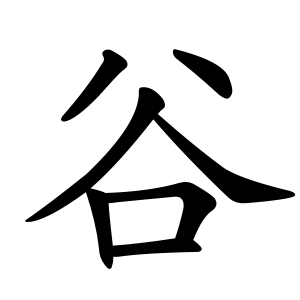谷
- valley, gorge;
It refers to a natural low area between hills or mountains.
Etymology
Its form is inspired by the shape of a mountain entrance resembling a triangle or a mouth (口) at the bottom, topped with the symbol 八 (which looks like the number eight), repeated two or three times.
This visually represents water springing out and flowing through a mountain area — essentially a natural water channel or valley.
谷 shares a root with 江 (river), both having a velar initial consonant. The difference is in the final consonant: 江 has a nasal ending, while 谷 has a stop ending.
Usage in Korean
谷 is commonly used in Korean and Chinese place names to indicate valleys or mountainous regions.
Place names ending with "곡" generally use this character.
Example characters that use this radical:
豁 (meaning “open valley” or “cleared pass”),
谿 (meaning “stream” or “brook”),
豅 (meaning “large and long valley”).
Additional notes
In simplified Chinese, 谷 is also used as the simplified character for 穀 (grain, 곡식 곡).
Similar shape characters
The character 𧮫 (meaning "to smile" or "upper lip") looks very similar to 谷, and they are often confused when 谷 is used as a phonetic component.
A hint for distinguishing is that characters with 𧮫 as the phonetic usually have initial consonants different from 'ᄀ', unlike those with 谷 as phonetic.
Words that derived from 谷
- 金人口 (COR)
- ⿳ 八 人 口
